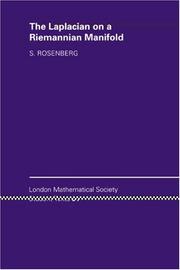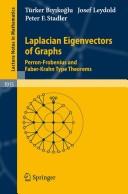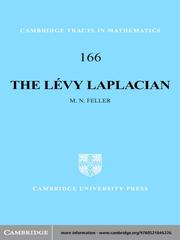| Listing 1 - 8 of 8 |
Sort by
|

ISBN: 1316087174 0511944675 1107362067 051162378X 1107366976 1299409083 1107364515 9781107362062 9780511623783 9780511961540 0511961545 9780521463003 0521463009 9780521468312 0521468310 Year: 1997 Publisher: Cambridge, U.K. New York, NY, USA
Abstract | Keywords | Export | Availability | Bookmark
 Loading...
Loading...Choose an application
- Reference Manager
- EndNote
- RefWorks (Direct export to RefWorks)
This text on analysis of Riemannian manifolds is a thorough introduction to topics covered in advanced research monographs on Atiyah-Singer index theory. The main theme is the study of heat flow associated to the Laplacians on differential forms. This provides a unified treatment of Hodge theory and the supersymmetric proof of the Chern-Gauss-Bonnet theorem. In particular, there is a careful treatment of the heat kernel for the Laplacian on functions. The Atiyah-Singer index theorem and its applications are developed (without complete proofs) via the heat equation method. Zeta functions for Laplacians and analytic torsion are also treated, and the recently uncovered relation between index theory and analytic torsion is laid out. The text is aimed at students who have had a first course in differentiable manifolds, and the Riemannian geometry used is developed from the beginning. There are over 100 exercises with hints.
Riemannian manifolds. --- Laplacian operator. --- Operator, Laplacian --- Differential equations, Partial --- Manifolds, Riemannian --- Riemannian space --- Space, Riemannian --- Geometry, Differential --- Manifolds (Mathematics)

ISBN: 9783540735090 3540735097 9786610951642 1280951648 3540735100 Year: 2007 Publisher: Berlin ; Heidelberg ; New York : Springer,
Abstract | Keywords | Export | Availability | Bookmark
 Loading...
Loading...Choose an application
- Reference Manager
- EndNote
- RefWorks (Direct export to RefWorks)
Eigenvectors of graph Laplacians have not, to date, been the subject of expository articles and thus they may seem a surprising topic for a book. The authors propose two motivations for this new LNM volume: (1) There are fascinating subtle differences between the properties of solutions of Schrödinger equations on manifolds on the one hand, and their discrete analogs on graphs. (2) "Geometric" properties of (cost) functions defined on the vertex sets of graphs are of practical interest for heuristic optimization algorithms. The observation that the cost functions of quite a few of the well-studied combinatorial optimization problems are eigenvectors of associated graph Laplacians has prompted the investigation of such eigenvectors. The volume investigates the structure of eigenvectors and looks at the number of their sign graphs ("nodal domains"), Perron components, graphs with extremal properties with respect to eigenvectors. The Rayleigh quotient and rearrangement of graphs form the main methodology.
Eigenvectors. --- Laplacian operator. --- Graph theory. --- Vecteurs --- Laplacien --- Théorie des graphes --- Eigenvectors --- Laplacian operator --- Graph theory --- Applied Physics --- Algebra --- Engineering & Applied Sciences --- Mathematics --- Physical Sciences & Mathematics --- Graphs, Theory of --- Theory of graphs --- Operator, Laplacian --- Extremal problems --- Mathematics. --- Algebra. --- Matrix theory. --- Combinatorics. --- Linear and Multilinear Algebras, Matrix Theory. --- Combinatorics --- Mathematical analysis --- Math --- Science --- Combinatorial analysis --- Topology --- Differential equations, Partial --- Matrices --- Vector spaces --- Eigenfactor
Book
ISBN: 8847007518 8847007526 Year: 2009 Publisher: Milano : Springer Milan : Imprint: Springer,
Abstract | Keywords | Export | Availability | Bookmark
 Loading...
Loading...Choose an application
- Reference Manager
- EndNote
- RefWorks (Direct export to RefWorks)
This book is designed as an advanced undergraduate or a first-year graduate course for students from various disciplines like applied mathematics, physics, engineering. The main purpose is on the one hand to train the students to appreciate the interplay between theory and modelling in problems arising in the applied sciences; on the other hand to give them a solid theoretical background for numerical methods, such as finite elements. Accordingly, this textbook is divided into two parts. The first one has a rather elementary character with the goal of developing and studying basic problems from the macro-areas of diffusion, propagation and transport, waves and vibrations. Ideas and connections with concrete aspects are emphasized whenever possible, in order to provide intuition and feeling for the subject. For this part, a knowledge of advanced calculus and ordinary differential equations is required. Also, the repeated use of the method of separation of variables assumes some basic results from the theory of Fourier series, which are summarized in an appendix. The main topic of the second part is the development of Hilbert space methods for the variational formulation and analysis of linear boundary and initial-boundary value problemsemph{. }% Given the abstract nature of these chapters, an effort has been made to provide intuition and motivation for the various concepts and results. The understanding of these topics requires some basic knowledge of Lebesgue measure and integration, summarized in another appendix. At the end of each chapter, a number of exercises at different level of complexity is included. The most demanding problems are supplied with answers or hints. The exposition if flexible enough to allow substantial changes without compromising the comprehension and to facilitate a selection of topics for a one or two semester course.
Differential equations, Partial. --- Electronic books. -- local. --- Laplacian operator. --- Calculus --- Mathematics --- Physical Sciences & Mathematics --- Operator, Laplacian --- Mathematics. --- Partial differential equations. --- Partial Differential Equations. --- Partial differential equations --- Math --- Science --- Differential equations, Partial --- Differential equations, partial.

ISBN: 9780521846226 9780511543029 9780521183840 0511132808 9780511132803 0511131445 9780511131448 0511543026 0521846226 0511132263 9780511132261 1107152267 9786610416042 0511200846 0511311117 Year: 2005 Publisher: Cambridge, UK New York Cambridge University Press
Abstract | Keywords | Export | Availability | Bookmark
 Loading...
Loading...Choose an application
- Reference Manager
- EndNote
- RefWorks (Direct export to RefWorks)
The Lévy Laplacian is an infinite-dimensional generalization of the well-known classical Laplacian. The theory has become well developed in recent years and this book was the first systematic treatment of the Lévy-Laplace operator. The book describes the infinite-dimensional analogues of finite-dimensional results, and more especially those features which appear only in the generalized context. It develops a theory of operators generated by the Lévy Laplacian and the symmetrized Lévy Laplacian, as well as a theory of linear and nonlinear equations involving it. There are many problems leading to equations with Lévy Laplacians and to Lévy-Laplace operators, for example superconductivity theory, the theory of control systems, the Gauss random field theory, and the Yang-Mills equation. The book is complemented by an exhaustive bibliography. The result is a work that will be valued by those working in functional analysis, partial differential equations and probability theory.
Functional analysis --- Laplacian operator. --- Lévy processes. --- Harmonic functions. --- Functions, Harmonic --- Laplace's equations --- Bessel functions --- Differential equations, Partial --- Fourier series --- Harmonic analysis --- Lamé's functions --- Spherical harmonics --- Toroidal harmonics --- Random walks (Mathematics) --- Operator, Laplacian --- Levy processes.
Book
ISBN: 3319237896 331923790X Year: 2015 Publisher: Cham : Springer International Publishing : Imprint: Springer,
Abstract | Keywords | Export | Availability | Bookmark
 Loading...
Loading...Choose an application
- Reference Manager
- EndNote
- RefWorks (Direct export to RefWorks)
This works focuses on regularity theory for solutions to the p-Laplace equation in the Heisenberg group. In particular, it presents detailed proofs of smoothness for solutions to the non-degenerate equation and of Lipschitz regularity for solutions to the degenerate one. An introductory chapter presents the basic properties of the Heisenberg group, making the coverage self-contained. The setting is the first Heisenberg group, helping to keep the notation simple and allow the reader to focus on the core of the theory and techniques in the field. Further, detailed proofs make the work accessible to students at the graduate level.
Calculus --- Mathematics --- Physical Sciences & Mathematics --- Laplacian operator. --- Harmonic functions. --- Functions, Harmonic --- Laplace's equations --- Operator, Laplacian --- Mathematics. --- Differential equations. --- Ordinary Differential Equations. --- Bessel functions --- Differential equations, Partial --- Fourier series --- Harmonic analysis --- Lamé's functions --- Spherical harmonics --- Toroidal harmonics --- Differential Equations. --- 517.91 Differential equations --- Differential equations
Book
ISSN: 14397382 ISBN: 128106646X 9786611066468 3540718974 Year: 2007 Publisher: Berlin ; New York : Springer,
Abstract | Keywords | Export | Availability | Bookmark
 Loading...
Loading...Choose an application
- Reference Manager
- EndNote
- RefWorks (Direct export to RefWorks)
The existence, for every sub-Laplacian, of a homogeneous fundamental solution smooth out of the origin, plays a crucial role in the book. This makes it possible to develop an exhaustive Potential Theory, almost completely parallel to that of the classical Laplace operator. This book provides an extensive treatment of Potential Theory for sub-Laplacians on stratified Lie groups. In recent years, sub-Laplacian operators have received considerable attention due to their special role in the theory of linear second-order PDE's with semidefinite characteristic form. It also provides a largely self-contained presentation of stratified Lie groups, and of their Lie algebra of left-invariant vector fields. The presentation is accessible to graduate students and requires no specialized knowledge in algebra nor in differential geometry. It is thus addressed, besides PhD students, to junior and senior researchers in different areas such as: partial differential equations; geometric control theory; geometric measure theory and minimal surfaces in stratified Lie groups.
Potential theory (Mathematics) --- Harmonic functions. --- Laplacian operator. --- Lie groups. --- Differential equations, Partial. --- Groups, Lie --- Lie algebras --- Symmetric spaces --- Topological groups --- Partial differential equations --- Operator, Laplacian --- Differential equations, Partial --- Functions, Harmonic --- Laplace's equations --- Bessel functions --- Fourier series --- Harmonic analysis --- Lamé's functions --- Spherical harmonics --- Toroidal harmonics --- Green's operators --- Green's theorem --- Potential functions (Mathematics) --- Potential, Theory of --- Mathematical analysis --- Mechanics --- Algebra. --- Differential equations, partial. --- Potential theory (Mathematics). --- Topological Groups. --- Partial Differential Equations. --- Potential Theory. --- Topological Groups, Lie Groups. --- Groups, Topological --- Continuous groups --- Mathematics --- Partial differential equations. --- Topological groups.
Book
ISBN: 3039215396 3039215388 Year: 2019 Publisher: MDPI - Multidisciplinary Digital Publishing Institute
Abstract | Keywords | Export | Availability | Bookmark
 Loading...
Loading...Choose an application
- Reference Manager
- EndNote
- RefWorks (Direct export to RefWorks)
This Special Issue aims to be a compilation of new results in the areas of differential and difference Equations, covering boundary value problems, systems of differential and difference equations, as well as analytical and numerical methods. The objective is to provide an overview of techniques used in these different areas and to emphasize their applicability to real-life phenomena, by the inclusion of examples. These examples not only clarify the theoretical results presented, but also provide insight on how to apply, for future works, the techniques used.
heteroclinic solutions --- non-instantaneous impulses --- Schauder’s fixed point theory --- dichotomy --- second-order differential/difference/q-difference equation of hypergeometric type --- differential equations --- a priori estimates --- global solutions --- generalized Liouville equation --- Hilbert space --- dissipation --- collocation method --- exponential dichotomy --- Sumudu decomposition method --- three-step Taylor method --- dynamical system --- lower and upper solutions --- problems in the real line --- Nagumo condition on the real line --- SIRS epidemic model --- first order periodic systems --- regular solutions --- Clairin’s method --- coupled nonlinear systems --- Navier–Stokes equations --- Bäcklund transformation --- asymptotic stability --- Caputo fractional derivative --- exponential stability --- difference equations --- lipschitz stability --- strong nonlinearities --- polynomial solution --- integro-differentials --- kinetic energy --- Legendre wavelets --- weak solutions --- discrete Lyapunov equation --- population dynamics --- non-uniform lattices --- Korteweg-de Vries equation --- time-dependent partial differential equations --- mean curvature operator --- functional boundary conditions --- mathematical modelling --- fixed point theory --- limit-periodic solutions --- Arzèla Ascoli theorem --- Miura transformation --- state dependent delays --- ?-Laplacian operator --- divided-difference equations --- effective existence criteria
Book
ISBN: 128245837X 9786612458378 1400829062 0691137323 0691137315 9781400829064 9780691137315 9780691137322 6612458372 Year: 2008 Publisher: Princeton, NJ
Abstract | Keywords | Export | Availability | Bookmark
 Loading...
Loading...Choose an application
- Reference Manager
- EndNote
- RefWorks (Direct export to RefWorks)
This book presents the analytic foundations to the theory of the hypoelliptic Laplacian. The hypoelliptic Laplacian, a second-order operator acting on the cotangent bundle of a compact manifold, is supposed to interpolate between the classical Laplacian and the geodesic flow. Jean-Michel Bismut and Gilles Lebeau establish the basic functional analytic properties of this operator, which is also studied from the perspective of local index theory and analytic torsion. The book shows that the hypoelliptic Laplacian provides a geometric version of the Fokker-Planck equations. The authors give the proper functional analytic setting in order to study this operator and develop a pseudodifferential calculus, which provides estimates on the hypoelliptic Laplacian's resolvent. When the deformation parameter tends to zero, the hypoelliptic Laplacian converges to the standard Hodge Laplacian of the base by a collapsing argument in which the fibers of the cotangent bundle collapse to a point. For the local index theory, small time asymptotics for the supertrace of the associated heat kernel are obtained. The Ray-Singer analytic torsion of the hypoelliptic Laplacian as well as the associated Ray-Singer metrics on the determinant of the cohomology are studied in an equivariant setting, resulting in a key comparison formula between the elliptic and hypoelliptic analytic torsions.
Differential equations, Hypoelliptic. --- Laplacian operator. --- Metric spaces. --- Spaces, Metric --- Operator, Laplacian --- Hypoelliptic differential equations --- Generalized spaces --- Set theory --- Topology --- Differential equations, Partial --- Alexander Grothendieck. --- Analytic function. --- Asymptote. --- Asymptotic expansion. --- Berezin integral. --- Bijection. --- Brownian dynamics. --- Brownian motion. --- Chaos theory. --- Chern class. --- Classical Wiener space. --- Clifford algebra. --- Cohomology. --- Combination. --- Commutator. --- Computation. --- Connection form. --- Coordinate system. --- Cotangent bundle. --- Covariance matrix. --- Curvature tensor. --- Curvature. --- De Rham cohomology. --- Derivative. --- Determinant. --- Differentiable manifold. --- Differential operator. --- Dirac operator. --- Direct proof. --- Eigenform. --- Eigenvalues and eigenvectors. --- Ellipse. --- Embedding. --- Equation. --- Estimation. --- Euclidean space. --- Explicit formula. --- Explicit formulae (L-function). --- Feynman–Kac formula. --- Fiber bundle. --- Fokker–Planck equation. --- Formal power series. --- Fourier series. --- Fourier transform. --- Fredholm determinant. --- Function space. --- Girsanov theorem. --- Ground state. --- Heat kernel. --- Hilbert space. --- Hodge theory. --- Holomorphic function. --- Holomorphic vector bundle. --- Hypoelliptic operator. --- Integration by parts. --- Invertible matrix. --- Logarithm. --- Malliavin calculus. --- Martingale (probability theory). --- Matrix calculus. --- Mellin transform. --- Morse theory. --- Notation. --- Parameter. --- Parametrix. --- Parity (mathematics). --- Polynomial. --- Principal bundle. --- Probabilistic method. --- Projection (linear algebra). --- Rectangle. --- Resolvent set. --- Ricci curvature. --- Riemann–Roch theorem. --- Scientific notation. --- Self-adjoint operator. --- Self-adjoint. --- Sign convention. --- Smoothness. --- Sobolev space. --- Spectral theory. --- Square root. --- Stochastic calculus. --- Stochastic process. --- Summation. --- Supertrace. --- Symmetric space. --- Tangent space. --- Taylor series. --- Theorem. --- Theory. --- Torus. --- Trace class. --- Translational symmetry. --- Transversality (mathematics). --- Uniform convergence. --- Variable (mathematics). --- Vector bundle. --- Vector space. --- Wave equation.
| Listing 1 - 8 of 8 |
Sort by
|

 Search
Search Feedback
Feedback About UniCat
About UniCat  Help
Help News
News